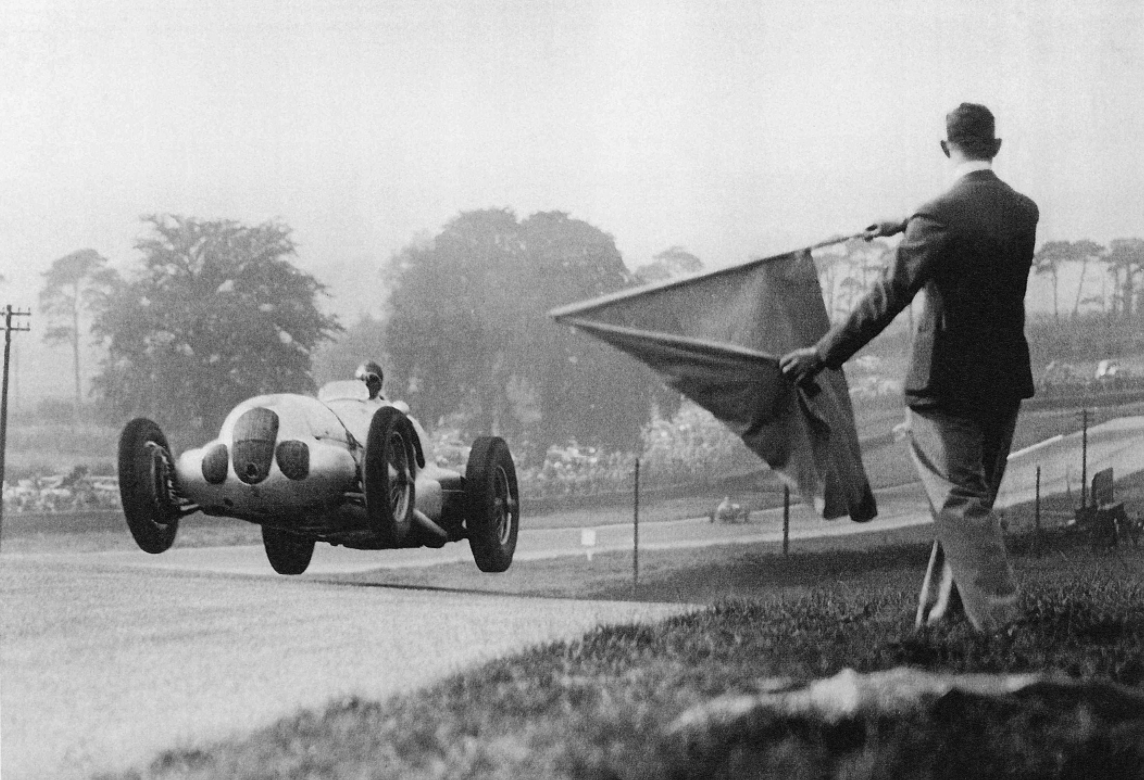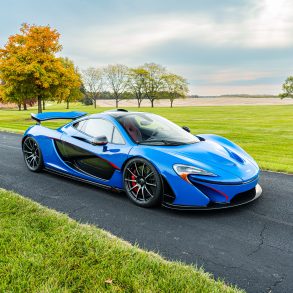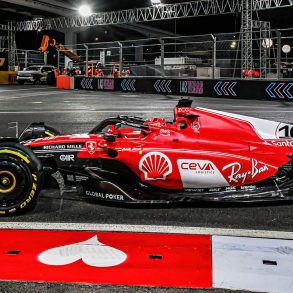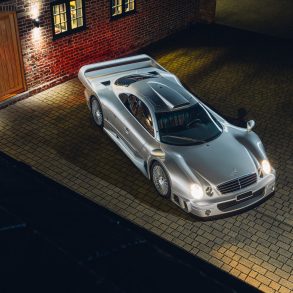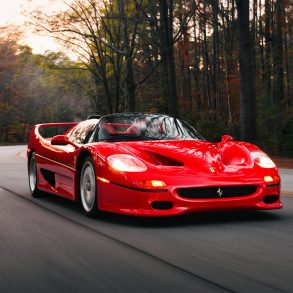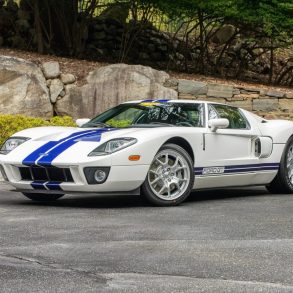1937 Donington Grand Prix – When The Germans Came to Donington
by Rodney Walkerley
The Donington Grand Prix of 1937 was the race and the year in which the already legendary German Grand Prix cars made their first appearance in Great Britain.
Although I had been watching these cars and reporting their races since they first emerged from their factories in 1934, the race on that October day remains in my memory, not so much on account of the racing, which developed on the usual lines, but because of little incidents and one moment which was profoundly impressive.
There were the remarks of a group of journalists who were attending the race to observe the German Grand Prix machines for the first time. We were standing in the autumn sunshine during the first practice session on the sloping grass overlooking the so-called Hairpin Bend, which was a sharp, right-angled turn to the right on an uphill gradient at the foot of a fast, curving downhill approach with the woods on one side and the famous blasted oaks of Donington in the parkland on the other. Behind us the celebrated mansion of Donington, once the residence of a dissolute nobleman of the 18th century, a prisoner of war camp in World War One, and at the time in question a kind of hotel and restaurant for visitors to what had become a Derbyshire pleasure park open to the public.
The enterprise of the Derby and District Motor Club, led by the energy of brusque Fred Craner, who used adjectives when referring to a spade and was no respecter of persons, especially those we now call “VIPs” turned the roads of the estate into a racing circuit for motorcyclists. The immediate success of the venture led to motor racing, then to the steady extension of the circuit and the organization of important, international events.
That day the circuit measured 3 1/8 miles. It was shaped rather like a distorted frying pan, of which the “handle” was the latest extension of the course. The start and pits were on a very short straight at the top of a sharp uphill known as Melbourne Rise.
Then came a right angle to the left (Red Gate), a long curving run downhill through Holly Wood and down, through a fast left-hander to the Hairpin, where we were grouped, waiting. Beyond us, the course wound away gently uphill and out of sight among the trees, through the yellow arch of the famous Stone Bridge (with room for one car at a time) to the near 90-degree turn of McLean’s Corner in the woods and so to Coppice Corner, which was a right-hander sharper than a right angle. From here the road passed through scattered farm buildings and out on to the fastest section of all – the long mille and a half, with gentle, full-throttle curves, into the final dead straight line of Starkey’s Straight which ended with the quite steep dip down, past the back of the pits, to the U-turn of Melbourne Hairpin. The course then returned uphill to the pits and grandstand enclosure at the top.
The practicing had just begun. Away beyond the woods we heard the approaching scream of a well-tuned E.R.A. and down the winding slope towards us came Raymond Mays. He changed down, braked, skirted round the Hairpin and was gone.
“There’s the winner,” remarked one of my friends. “Knows this course backwards.”
Half a minute later came the deeper note of a 2.9-litre Maserati, and “B. Bira” (Prince Birabongse of Siam, Mays’ nearest rival and a new star in the racing firmament) shot past us, cornering with that precision which marked him as the master he was.
“Or him,” said another.
We waited again. Then they came.
Far away in the distance we heard an angry, deep-throated roaring – as someone once remarked, like hungry lions impatient for the arena. A few moments later, Manfred von Brauchitsch, red helmeted, brought a great, silver projectile snaking down the hill, and close behind, his teammate Rudolf Caracciola, then at the height of his great career. The two cars took the hairpin, von Brauchitsch almost sideways, and rocketed away out of sight with long plumes of rubber smoke trailing from their huge rear tyres, in a deafening crash of sound.
The startled Pressmen gazed at each other, awe-struck.
“Strewth,” gasped one of them, “so that’s what they’re like!”
That was what they were like.
These were the fabulous machines which could top 190 m.p.h. on the long straights at Rheims and Spa and Pescara and which, on the twists and turns of the mountainous Nurburgring, scrubbed the tread from the tyres in 80 miles. On the starting line they weighed just over a ton, 75-gallon tanks filled to the brim to be emptied at the rate o 3 to 4 miles per gallon.
This was the era of yet another Formula designed to reduce the speeds of road racing and which produced cars so fast that it has taken over 20 years to break their lap records. The size of engine was left to the designer’s choice. His problem was to make a car, which weighed only 750 kg., about 141 cwt., with empty tanks and no tyres.
In their wisdom, the lawgivers, then as now, thought that such a maximum weight limit would reduce racing speeds by reducing the possible size of engines to something like 3 litres. That afternoon, four years after the Formula has been in operation, the Mercedes had eight-cylinder engines of 5.7 litres, developing not far short of 650 brake horse power, for a chassis weight of 141 cwt. and a total weight on the starting line of 21 cwt. The long stroke, supercharged engines, with four valves per cylinder, turned over at 5,800 r.p.m. By the way, that was the year the Mercedes had de Dion rear suspension for the first time, and set a vogue which has become a sine qua non on racing cars ever since.
The rivals, the Auto Unions, were the product of the German combine of Horch, Audi, DKW and Wanderer and were the un-orthodox design of Dr. Ferdinand Porsche, whose name cropped up during the war with a less popular design, the heavy Tiger tank. The main feature of this remarkable car was a V-16 600 h.p., engine of just over 6 litres mounted behind the driver (who sat well forward in the nose) but in front of the back axle, behind which protruded the gearbox. The Formula I and 2 Coopers of today are rather like miniature reproductions, but the Auto Union of that year still retained swing axles at the rear. Both Mercedes and Auto Union used independent front suspension.
The deafening, deep-throated bellow of the 16-cilinder engines was like the sound of a diving aeroplane, sending a tingle down the spine.

No. 2 in the team was the ex-mechanic, squat, broadly built Hermann Lang, who was to become their most brilliant driver. He, too, returned to racing after the war with the Mercedes 300SL models, but the touch had gone. Their No. 3 was the ebullient nephew of a German general, young Manfred von Brauchitsch when last heard of, operating a transport business in Hamburg. Fourth man was the young Englishman Dick Seaman, who had accepted the invitation to join them after a meteoric series of successes with the 1927 1,500 c.c. straight-eight Delage. Dick was to win the German Grand Prix of 1938 and then, a few months after his marriage to Erica Popp, daughter of a B.M.W. director, he was killed while leading the Belgian Grand Prix at Spa the following year. The reserve driver was a young Swiss, but recently down from Cambridge, Christian Kautz. He, too, met his death at the wheel, driving a Maserati on the ill-fated Bremgarten circuit in his native Switzerland in the Grand Prix of 1948.

His place was taken by Rudolf Hasse, a newcomer, supporting Hans Muller, an ex-motorcyclist who showed, but never fulfilled, much promise.
Filling up the rest of the field were the British contingent with their second-hand Maseratis and their 1½-litre E.R.A.s. “B. Bira” had the 2.9-litre Maserati which Whitney Straight had driven so brilliantly, A. B. Hyde had a 2.6-litre, Robin Hanson a 1,500 c.c. version; on E.R.A.s were Raymond Mays, Lord Howe, Charles Martin, Arthur Dobson, Reggie Tongue (now of the praesidium at Oulton Park) and Peter Whitehead, and smiling Percy Maclure had his unsupercharged 1,500 c.c. Riley, which used to take the grin off many a face-all outclassed that day, but all brilliantly driven, but none finished within the time limit.
The Germans found the course very rough but otherwise as good as anything in Europe. At first they used Nürburg axle ratios, which were too low, and after a change, the speed down Starkey’s Straight went from 155 to 170 m.p.h. at once.
A dull, grey autumn morning melted into warm sunshine by noon, with the woodlands already tinged with yellow and russet and bronze. A crowd, 60,000 strong and enormous by British standards at that time, converged in long queues, a yard at a time, on the beautiful circuit. The car parks were packed with cars glittering in the sun and for once the big grandstand and the enclosures were full. Down below the grandstand we could see the bookmakers with their little blackboards – betting was permitted in those days, as at Goodwood now. An inspection of the odds was another indication of the public’s knowledge of Grand Prix racing: 3 to I Caracciola 5 to I Rosemeyer . . . evens Mays! The German mechanics promptly backed their men to the hilt. One by one the gleaming racing machines were marshaled on the starting grid at the top of Melbourne Rise – Brauchitsch (Mercedes) taking Number 1 place with a record lap at 86.01 m.p.h., Rosemeyer (Auto Union) next to him, with 85.36 m.p.h., Lang and Seaman (83.58 and 82.58 m.p.h.) completing the line for Mercedes.
In the second row were Muller (Auto Union), Caracciola (Mercedes), Who had made no great efforts in the practicing, and Hasse (Auto Union). Bira, Mays and Howe led the British contingent in the third rank. Rosemeyer, carefree as usual, chatted until the last moment but Brauchitsch seemed strung-up, nervy and sullen.
With 30 seconds to go the German engines started up, the drivers holding them at an even 1,500 r.p.m., not revving up and down in the manner usual with smaller cars, and as the flag went up, the revs mounted to a steady shattering, thunderous roar and then they surged away with tyre treads belching smoke, leaving long black lines to show where they had stood. That fantastic start in an inferno of suddenly unleashed sound was something that left the packed crowds awe-struck, open-mouthed, silent.
Away they went in the usual insane traffic jam, round Red Gate, stringing out, and away through the woods, and behind them trailed the E.R.A.s, outmatched already. The vibrant thunder died gradually away in the distance and we waited, hushed our stopwatches in hand.
One minute . . . one minute thirty seconds . . . and then, far away, came the droning as if of distant aeroplanes. The drone rose to a roar, and there, twinkling silver in the sun, they came, down Starkey’s Straight in full view, one behind the other at 170 m.p.h., a speed never before seen in Britain.
The seven German cars, nose to tail, the rest nowhere at all, tore past the back of the pits and fled downhill into Melbourne’s 15 m.p.h. hairpin. Round they swirled and then they were upon us. At 100 m.p.h. they shot over the crest of the ridge, all four wheels clear of the ground with the impetus of that phenomenal acceleration. The Mercedes came with front wheels a foot off, the Auto Unions with similar daylight under their rear wheels.
In a crash of sound they went past, cut, braked and cornered into Red Gate again – Lang in the lead, Caracciola, from the second rank, 4 sec. behind him, Brauchitsch third, Seaman fourth, Rosemeyer fifth, Muller and Hasse sixth and seventh. Then, after a long pause, Bira (Maserati), Martin and Mays and Howe on the E.R.A.s.
And as once again the thunder dwindled into silence, a great audible gasp went up from the enclosure. Men took off their caps and wiped their brows and turned to stare at each other in amazement. This was the sort of racing they had read about. Now they saw it, for the first time. And they were thunderstruck.

The race developed much as those races developed. In the enclosures overlooking the Hairpin, where the drivers were coming down the hill, snaking and sliding and taking the corner almost sideways under their immense power, conversation was limited to gasps and ejaculations.
From The Motor, at the time: “Brauchitsch and Rosemeyer were taking McLean’s flat out, in long slides, wonderfully controlled; they took Holly Wood in one long skid, they came down to the Hairpin with the tails feet out of line . . .”

For ten laps Rosemeyer slung the Auto Union round faster and faster until he rode Brauchitsch’s tail at only I½ sec. – perhaps four lengths, and Brauchitsch was skid cornering now with what was left of his 7 by 19 in. rear tyres almost on fire.
After 22 of the 80 laps of this race, he dashed up to his pit for the wheel-change and a tankful of fuel. Just 33 sec. later he was rocketing off again, and Rosemeyer was in the lead by half a minute, Caracciola second, Brauchitsch third. Lang was at rest 55 sec., while a shock absorber was examined, which dropped him to seventh place. Two laps later he came slowly in again with the shock absorber broken, and Seaman’s damaged damper was trailing under the car. He, too, pulled straight on to the grass by the pits, finished.
Caracciola was signaled about his tyre change but shook his head and held on his way. He was cornering fast but carefully and, having realized the shock when the car leapt into the air at the top of Melbourne Rise and hit the road again, he took that slope more gently than anyone else.

Driving on the absolute limit in his somewhat desperate style, Brauchitsch lapped faster and faster, raising the lap record to 85.62 m.p.h. and raced two lengths behind Caracciola. You will observe that in the Mercedes team inter-driver rivalry was rather encouraged than disciplined. On the 36th lap Brauchitsch hurled his car past Caracciola, acknowledged champion of his day, although no official title was awarded at that time, and led him by three lengths, and Rosemeyer held his Auto Union in third place, 16 or 17 sec. behind, knowing that a second wheel change was still to come, and half the race yet to be fought. Muller and Hasse were now three miles behind the battle.
On lap 40, the halfway mark, Caracciola made his first and only stop amidst a roar of cheering from crowds dancing with excitement (few sat in their grandstand seats for more than a few minutes that afternoon). In went the fuel, on went the rear wheels and away went the car with the noise of an aeroplane taking off-32 sec. dropped at the stop, and Rosemeyer, with a speed that equaled the lap record, zoomed into Caracciola’s second place behind Brauchitsch.
The German pits used pressure fuel hoses, which forced the pungent-smelling alcohol melange into the tanks at the rate of more than a gallon a second, and had to be very carefully controlled. In contrast, using churns and funnel, Lord Howe lost I min. 5 sec. refueling his E.R.A.
At 52 laps Brauchitsch came in for his second set of rear wheels (Caracciola had made his lyres last half the race and would obviously last the rest of it on his new ones). Brauchitsch was at rest for 32 sec., and sat watching as Rosemeyer flashed past into the lead at last. On the restart, Brauchitsch was 10 sec. behind, and some 20-sec. ahead of Caracciola. On the next few laps Rosemeyer drew away to 20 sec., averaging 83 m.p.h. and Caracciola had dropped back by a minute. Waiting? Or down on revs?
There was earnest conference in the Auto Union pit and, on the 61st lap, two mechanics held up a wheel as Rosemeyer roared past again. On that lap, coming down Starkey’s straight on full throttle, there was a bang as one of Brauchitsch’s heavily stressed rear tyres burst. The great car lurched and snaked madly at that dizzy speed, but he held it, slowed down, and came to the pits with the tyre a flurry of flapping cords like a bundle of knitting flailing round and almost on fire. The replacement cost 28 sec., and left Rosemeyer secure in the lead, even after his second wheel change in 31 sec. (the hot engine was stubborn on the restart).
Brauchitsch, in pursuit, was enjoying himself hugely. When the British drivers, laps behind the race, moved over to let him through, he waved gaily as he sped by; he waved to the crowds and, as he slewed the Mercedes through the curves in his characteristic slide, he was grinning broadly with sheer pleasure. But he could not close that half-minute gap, nor could Caracciola get to grips with him from third place and Muller and Hasse were still nearly a lap behind, but 6 miles ahead of the “light brigade” led by Bira’s Maserati.
Over the final ten laps with the positions obviously static, the leaders slowed down slightly, braking more gently, changing up earlier as they came out of corners, so that the average declined fractionally to just under 83 m.p.h. – and Rosemeyer had worn through the seat of his pants! As they finished, there was a difference of a mere 0.38 m.p.h. between the first three-equivalent to I min. 16.6 sec. As we streamed towards the car parks, I heard a man remark: “Well, I’ll never forget that first lap.
1937 Donington Grand Prix Results
| 1st | B. Rosemeyer | Auto Union | 3hr. 1min. 2.2sec. | 82.86 mph |
| 2nd | M. von Brauchitsch | Mercedes | 3hr. 1min. 40sec. | 82.57 mph |
| 3rd | R. Caracciola | Mercedes | 3hr. 2min. 18.8 sec. | 82.28 mph |


